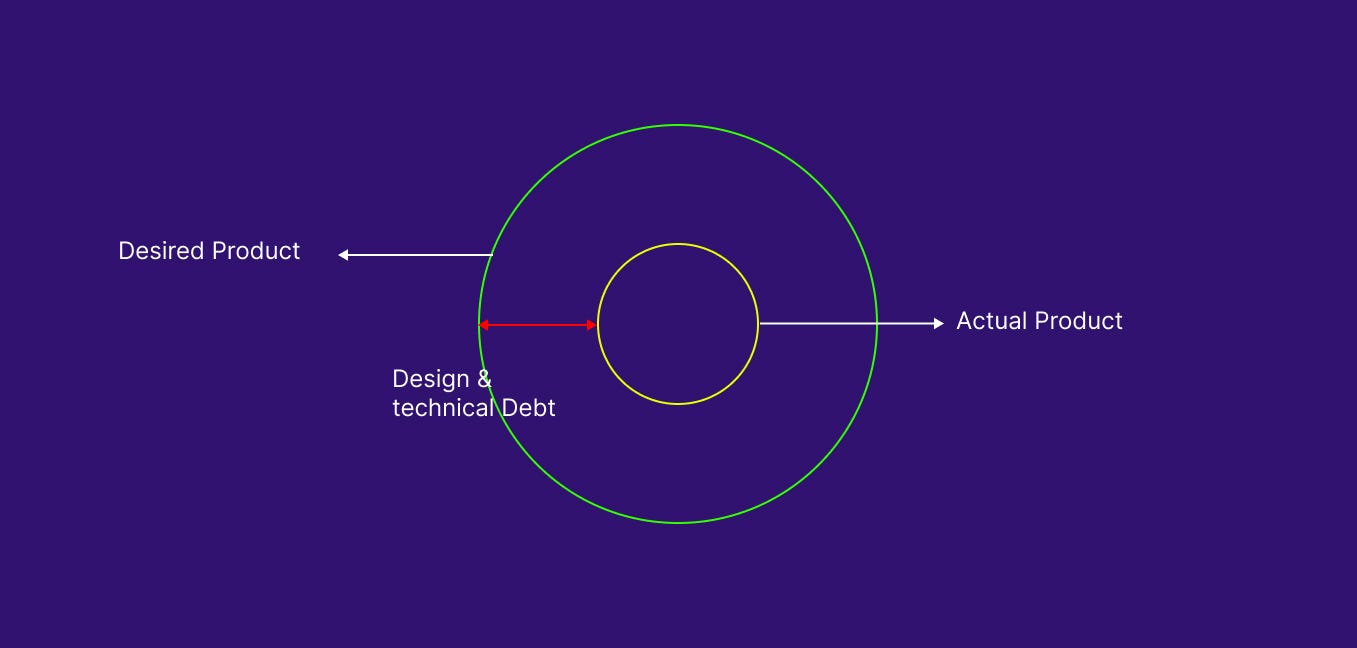You manage “Design Debt”, You manage rocky UX !
How design debt can alienate users and downfall of your product
05 Feb '24
5 min read

 Being a designer have you ever heard this….
Being a designer have you ever heard this….
“Let’s just do this, we can think of building a design system later. We need this screen ASAP”
Being a designer I have heard this way too many times than I should have. And nothing will be solved blaming another person in the company for this. They are just trying to reach their target of the quarter, you should make one and reach it too!
Design debt in UX design refers to the accumulated shortcomings or compromises in the user experience of a product or interface that have been made over time. This term is derived from the concept of technical debt in software development, which refers to the long-term consequences of choosing an easy but suboptimal solution over a more complex but better one.
Design debt is inevitable to certain extent but generally it becomes a real problem when future of UX is never thought of as a company, we consistently deliver just what is urgently asked, NOTHING ELSE!
Here are some common causes of design debt in UX:
- No North Star: As a company, there is no larger design goal which means there is no larger purpose and hence, they are doing what they are told.
- Time Constraints: Designers may face tight deadlines, leading to rushed decisions and no periodic maintenance.
- Lack of Research: Insufficient user research or testing can result in design decisions that do not align with user needs.
- Technological Constraints: Limitations in technology or platform capabilities may lead to compromises in design.
- No design system: This leads to inconsistent designs and unscalable UX.

In a survey conducted by Pendo, 72% of respondents said they have encountered issues with user experience in their organization, with 30% attributing these issues to a lack of investment in UX design.
source:link
In a scenario where there’s no existing design system, and the design team is small, it’s essential to adopt proactive strategies to prevent the accumulation of design debt. Here are some practical steps to help minimize design debt in such a context:
- Establish Design Principles:Simple and straightforward guidelines will do. align with the brand and user needs. These principles can serve as a foundation for consistent decision-making, even in the absence of a formal design system.
- Document Document Document:Create a shared document or wiki to record design decisions, rationale, and guidelines. This documentation helps maintain a shared understanding among team members and can serve as a reference point for future work.
- Regular Design Review Audits: To keep all check and balance a regular review will point out any inconsistencies and can be fixed straight away. Refactor the inconsistencies and watch your patterns so it’s not repeated. Never underestimate the power of a second opinion.
- Iterative Design Approach:Embrace an iterative design process. Start with simple, functional designs and refine them based on feedback and evolving requirements. Avoid perfectionism upfront and focus on delivering usable solutions that can be improved over time.
- Prioritize High-Impact Areas:Identify critical areas of the product where consistency and usability are most crucial. Prioritize addressing design debt in these high-impact areas to maximize the positive impact on the user experience.
- Invest in Education:Provide training and education for team members on design best practices and principles. This can help the team keep up to date with design trends and principles.
- Baby steps into a Design system: Slowly collaborate with the team members and build a basic design system. Begin building a design system incrementally by identifying reusable components or patterns that emerge in different parts of the product.As and when you move along different features, add them to design system. This is where design principles will help harmonising everything.
But if you as a designer can manage all the above given steps, it will just be easier to start building one. you do not have to think of moving the whole mountain but you surely can start by breaking down the smallest rock! Do not take it too seriously and just start. Here is how you can start.
Do not wait till the end when it’s too late discuss company’s north start with the leadership & conduct periodic meetings to check if the design system is making progress.

If you wait too long, Design debt can be overwhelming. It doesn’t have to be!
Just like you’d call a restoration expert for pesky water leaks, our team can swoop in and tackle your design woes before they become design sinkholes! 💦💥
It should be all about comprehensive audits and prioritising issues to get your design game back on track. Plus, build a rock-solid governance plan to keep that debt at bay!
Let’s face it, a design system audit is like a style check for your digital wardrobe — gotta make sure everything matches and fits just right! 👗💼
Ready to level up your design game? Let’s chat about how we can fine-tune your system and make your UI sparkle like never before! ✨
#DesignSystemAudit #ConsistencyIsKey 💪 #nomoredebt #debtisleakage
Other article you read about it
Category:Technology
Written by Shreya Kumar
UX Designer from Bangalore
0 Followers
0 Following
